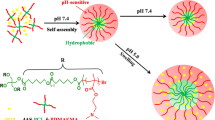Summary
Electrochemical reaction of FPEG is coupled with the preceding disassembled reaction of micelles in aqueous solution. The change in diffusion species fromthe micelles to the monomers at cmc in the concentration gradient in diffusion layers appeared in case of bulk electrolysis of FPEG. The drug releasing mechanism from the redox active micelles were clarified.
Access this chapter
Tax calculation will be finalised at checkout
Purchases are for personal use only
Similar content being viewed by others
References
Saji T, (1988) Electrochemical formation of a phthalocyanine thin film by disruption of micellar aggregates. Chem. Lett., 693–696
Takeoka Y, Aoki T, Sanui K, Ogata N, Yokoyama M, Okano T, Sakurai Y (1995) Electrochemical control of drug release from redox-active micelles. J. Controlled Release, 33: 79–87
Takeoka Y, Aoki T, Sanui K, Ogata N, Watanabe M, Electrochemical studies of a redox-active surfactants. Correlation between electrochemical responses and dissolved states. Langmuir, submitted.
Nicholson R S, Shain I (1964) Theory of stationary electrode polarography. Anal. Chem. 36:706–723
Marcus R A (1963) On the theory of oxidation-reduction reactions involving electron transfer. V. Comparison and properties of electrochemical and chemical rate constants. J. Phys. Chem. 67: 853–857
Marcus R A (1964) Chemical and electrochemical electron-transfer theory. Annu. Rev. Phys. Chem. 15: 155–196
Marcus R A (1965) On the theory of electron-transfer reactions. VI. Unified treatment for homogeneous and electrode reactions. J. Chem. Phys. 43: 679–701
Marcus R A, Sutin N (1985) Biochem. Biophys. Acta. 811: 265
Saji T, Hoshino K, Aoyagui S (1985) Reversible formation and disruption of micelles bycontrol of the redox state of the head group. J. Am. Chem. Soc. 107: 6865–6868
Author information
Authors and Affiliations
Editor information
Editors and Affiliations
Rights and permissions
Copyright information
© 1996 Springer-Verlag Tokyo
About this paper
Cite this paper
Takeoka, Y. et al. (1996). Drug Releasing Mechanism from Redox Active Micelles. In: Ogata, N., Kim, S.W., Feijen, J., Okano, T. (eds) Advanced Biomaterials in Biomedical Engineering and Drug Delivery Systems. Springer, Tokyo. https://doi.org/10.1007/978-4-431-65883-2_121
Download citation
DOI: https://doi.org/10.1007/978-4-431-65883-2_121
Publisher Name: Springer, Tokyo
Print ISBN: 978-4-431-65885-6
Online ISBN: 978-4-431-65883-2
eBook Packages: Springer Book Archive




